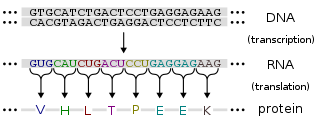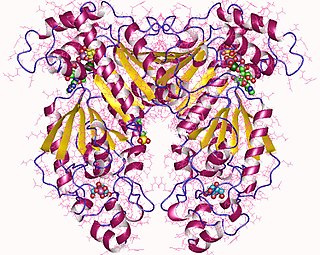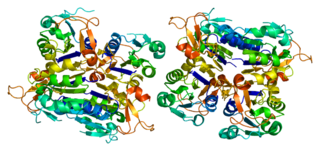Related Research Articles

Protein production is the biotechnological process of generating a specific protein. It is typically achieved by the manipulation of gene expression in an organism such that it expresses large amounts of a recombinant gene. This includes the transcription of the recombinant DNA to messenger RNA (mRNA), the translation of mRNA into polypeptide chains, which are ultimately folded into functional proteins and may be targeted to specific subcellular or extracellular locations.

Phosphofructokinase-2 (6-phosphofructo-2-kinase, PFK-2) or fructose bisphosphatase-2 (FBPase-2), is an enzyme indirectly responsible for regulating the rates of glycolysis and gluconeogenesis in cells. It catalyzes formation and degradation of a significant allosteric regulator, fructose-2,6-bisphosphate (Fru-2,6-P2) from substrate fructose-6-phosphate. Fru-2,6-P2 contributes to the rate-determining step of glycolysis as it activates enzyme phosphofructokinase 1 in the glycolysis pathway, and inhibits fructose-1,6-bisphosphatase 1 in gluconeogenesis. Since Fru-2,6-P2 differentially regulates glycolysis and gluconeogenesis, it can act as a key signal to switch between the opposing pathways. Because PFK-2 produces Fru-2,6-P2 in response to hormonal signaling, metabolism can be more sensitively and efficiently controlled to align with the organism's glycolytic needs. This enzyme participates in fructose and mannose metabolism. The enzyme is important in the regulation of hepatic carbohydrate metabolism and is found in greatest quantities in the liver, kidney and heart. In mammals, several genes often encode different isoforms, each of which differs in its tissue distribution and enzymatic activity. The family described here bears a resemblance to the ATP-driven phospho-fructokinases, however, they share little sequence similarity, although a few residues seem key to their interaction with fructose 6-phosphate.

Phosphoenolpyruvate carboxykinase is an enzyme in the lyase family used in the metabolic pathway of gluconeogenesis. It converts oxaloacetate into phosphoenolpyruvate and carbon dioxide.

Oxaloacetate decarboxylase is a carboxy-lyase involved in the conversion of oxaloacetate into pyruvate.

Leucyl aminopeptidases are enzymes that preferentially catalyze the hydrolysis of leucine residues at the N-terminus of peptides and proteins. Other N-terminal residues can also be cleaved, however. LAPs have been found across superkingdoms. Identified LAPs include human LAP, bovine lens LAP, porcine LAP, Escherichia coli LAP, and the solanaceous-specific acidic LAP (LAP-A) in tomato.

Nattokinase is an enzyme extracted and purified from a Japanese food called nattō. Nattō is produced by fermentation by adding the bacterium Bacillus subtilisvar natto, which also produces the enzyme, to boiled soybeans. While other soy foods contain enzymes, it is only the nattō preparation that contains the specific nattokinase enzyme.

Glycine decarboxylase also known as glycine cleavage system P protein or glycine dehydrogenase is an enzyme that in humans is encoded by the GLDC gene.

Thymidine kinase 1, soluble, is a human thymidine kinase.

Cyclooxygenase 1 (COX-1), also known as prostaglandin-endoperoxide synthase 1, is an enzyme that in humans is encoded by the PTGS1 gene. In humans it is one of two cyclooxygenases.
In enzymology, a lipoyl(octanoyl) transferase (EC 2.3.1.181) is an enzyme that catalyzes the chemical reaction

Alcohol dehydrogenase [NADP+] also known as aldehyde reductase or aldo-keto reductase family 1 member A1 is an enzyme that in humans is encoded by the AKR1A1 gene. AKR1A1 belongs to the aldo-keto reductase (AKR) superfamily. It catalyzes the NADPH-dependent reduction of a variety of aromatic and aliphatic aldehydes to their corresponding alcohols and catalyzes the reduction of mevaldate to mevalonic acid and of glyceraldehyde to glycerol. Mutations in the AKR1A1 gene has been found associated with non-Hodgkin's lymphoma.

Dipeptidase 1 (DPEP1), or renal dipeptidase, is a membrane-bound glycoprotein responsible for hydrolyzing dipeptides. It is found in the microsomal fraction of the porcine kidney cortex. It exists as a disulfide-linked homodimer that is glygosylphosphatidylinositol (GPI)-anchored to the renal brush border of the kidney. The active site on each homodimer is made up of a barrel subunit with binuclear zinc ions that are bridged by the Gly125 side-chain located at the bottom of the barrel.

Succinate-semialdehyde dehydrogenase, mitochondrial is an enzyme that in humans is encoded by the ALDH5A1 gene.

Zinc finger protein 24 is a protein that in humans is encoded by the ZNF24 gene.
Di Long or Dilong extract is a medicinal preparation based on abdominal extracts from the earthworm species Lumbricus rubellus used in traditional Chinese medicine (TCM) for a wide variety of disorders, from convulsions and fevers to rheumatoid arthritis and blood stasis syndromes.

Pyruvate kinase isozymes M1/M2 (PKM1/M2), also known as pyruvate kinase muscle isozyme (PKM), pyruvate kinase type K, cytosolic thyroid hormone-binding protein (CTHBP), thyroid hormone-binding protein 1 (THBP1), or opa-interacting protein 3 (OIP3), is an enzyme that in humans is encoded by the PKM2 gene.

Acetyl-CoA carboxylase 2 also known as ACC-beta or ACC2 is an enzyme that in humans is encoded by the ACACB gene.
Nepenthesin is an aspartic protease of plant origin that has so far been identified in the pitcher secretions of Nepenthes and in the leaves of Drosera peltata. It is similar to pepsin, but differs in that it also cleaves on either side of Asp residues and at Lys┼Arg. While more pH and temperature stable than porcine pepsin A, it is considerably less stable in urea or guanidine hydrochloride. It is the only known protein with such a stability profile.
Fibrolase is an enzyme. This enzyme catalyses the following chemical reaction
References
- ↑ Hu, R. (2004). "Codon optimization, expression, and characterization of recombinant lumbrokinase in goat milk". Protein Expression and Purification. 37 (1): 83–8. doi:10.1016/j.pep.2004.05.018. PMID 15294284.
- 1 2 3 Mihara, Hisashi; Sumi, Hiroyuki; Yoneta, Tomoyuki; Mizumoto, Hideaki; Ikeda, Ryuzo; Seiki, Masao; Maruyama, Masugi (1991). "A novel fibrinolytic enzyme extracted from the earthworm, Lumbricus rubellus". The Japanese Journal of Physiology. 41 (3): 461–472. doi: 10.2170/jjphysiol.41.461 . PMID 1960890.
- ↑ Ge, T.; Sun, Z.; Fu, S.; Liang, G. (2005). "Cloning of thrombolytic enzyme (lumbrokinase) from earthworm and its expression in the yeast". Protein Expression and Purification. 42 (1): 20–8. doi:10.1016/j.pep.2005.04.005. PMID 15927482.
- ↑ Kasim, M.; Kiat, A. A.; Rohman, M. S.; Hanifah, Y.; Kiat, H. (2009). "Improved Myocardial Perfusion in Stable Angina Pectoris by Oral Lumbrokinase: A Pilot Study". The Journal of Alternative and Complementary Medicine. 15 (5): 539–44. doi:10.1089/acm.2008.0506. PMID 19416019.